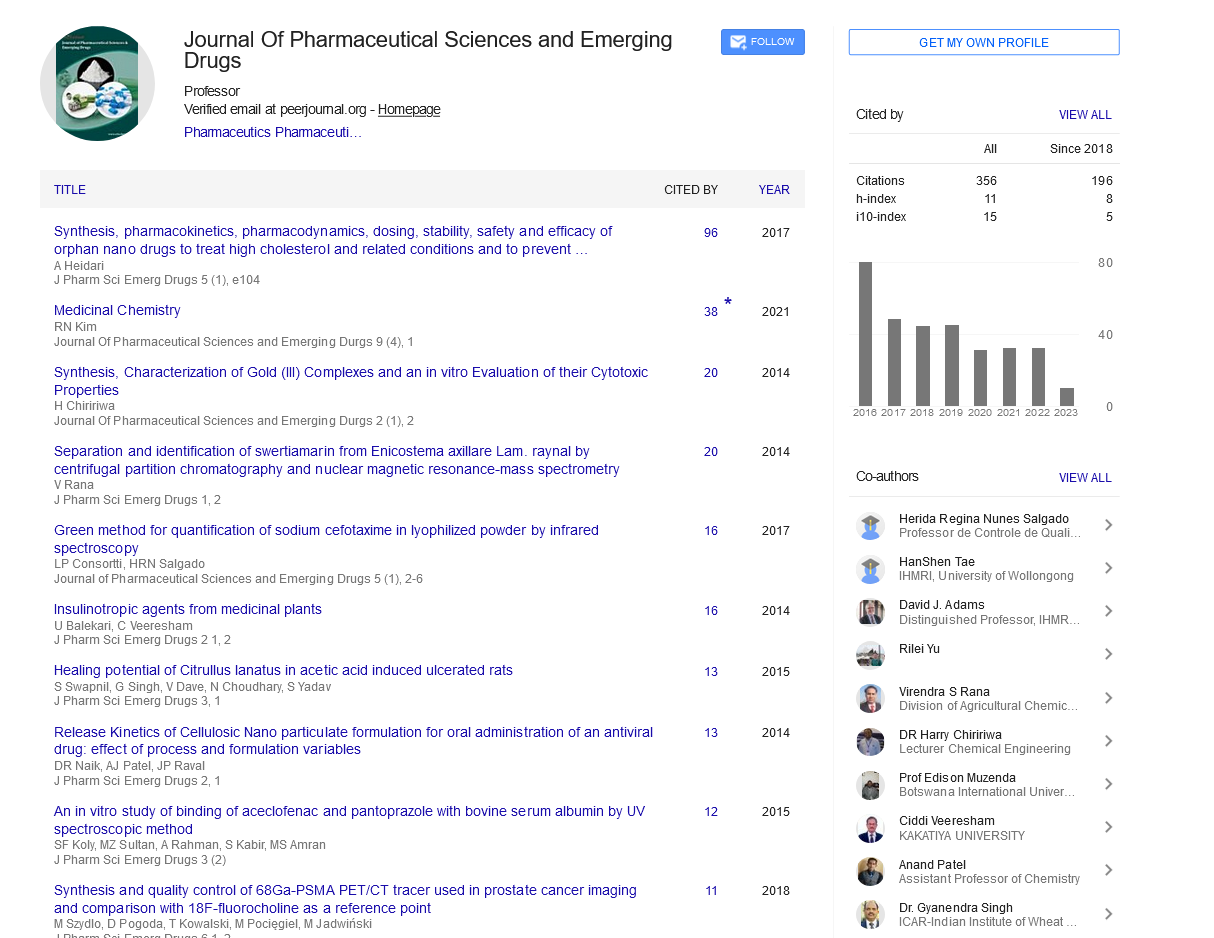Commentary, J Pharm Sci Emerg Drugs Vol: 12 Issue: 4
Advances in Bioanalytical Methodologies for Therapeutic Drug Monitoring
Nicola Brunello*
1Department of Pharmacology, University of Padova, Padova, Italy
*Corresponding Author: Nicola Brunello,
Department of Pharmacology, University
of Padova, Padova, Italy
E-mail: nicola17b@gmail.com
Received date: 21 July, 2024; Manuscript No: JPSED-24-148304
Editor assigned date: 23 July, 2024; PreQC No: JPSED-24-148304 (PQ);
Reviewed date: 06 August, 2024; QC No: JPSED-24-148304;
Revised date: 13 August, 2024; Manuscript No: JPSED-24-148304 (R);
Published date: 20 August, 2024; DOI no: 10.4172/2380-9477.1000194
Citation: Brunello N (2024) Advances in Bioanalytical Methodologies for Therapeutic Drug Monitoring. J Pharm Sci Emerg Drugs 12:4.
Description
Therapeutic Drug Monitoring (TDM) plays a major role in personalized medicine by ensuring that patients receive optimal drug dosages based on their individual needs. It is particularly important for drugs with narrow therapeutic indices, where a slight variation in dosage can lead to sub therapeutic effects or toxicity. Over the years, advances in bioanalytical methodologies have significantly improved the precision, accuracy and speed of TDM, allowing clinicians to optimize treatments for better outcomes.
Historically, TDM has relied on traditional techniques such as immunoassays and chromatographic methods like High-Performance Liquid Chromatography (HPLC) and Gas Chromatography (GC). Immunoassays, which detect specific drugs using antibodies, have been widely used due to their simplicity and speed. However, these methods often suffer from cross-reactivity and limited specificity, especially in complex biological matrices like blood or plasma.
Chromatographic techniques, on the other hand, offer greater accuracy and specificity, but they tend to be more time-consuming and require significant sample preparation. While these traditional approaches have been effective for many years, they are being increasingly supplemented or replaced by advanced bioanalytical techniques that offer enhanced sensitivity, faster processing times, and the ability to analyze multiple drugs simultaneously.
One of the most significant advances in bioanalytical methodologies for TDM is the integration of Mass Spectrometry (MS), particularly Liquid Chromatography-Tandem Mass Spectrometry (LC-MS/MS).
LC-MS/MS is now considered a gold standard in drug quantification due to its exceptional sensitivity and specificity. Unlike immunoassays, LC-MS/MS can simultaneously measure multiple analyses in a single run, which is important for monitoring patients on combination therapies. The technique's ability to differentiate between drug metabolites and parent compounds further enhances its utility in clinical settings.
Another major advancement is the development of microfluidicsbased systems. These systems miniaturize conventional analytical processes, leading to faster analysis times and reduced sample volumes. The application of biosensors in TDM has also shown great promise. Biosensors utilize biological recognition elements, such as enzymes or antibodies, to detect specific drug molecules in real time. These devices offer rapid and non-invasive monitoring of drug levels, potentially allowing for continuous TDM. For instance, wearable biosensors could provide real-time data on a patient’s drug concentrations, facilitating immediate dose adjustments and improving overall treatment outcomes.
In recent years, omics technologies, including proteomics and metabolomics, have been integrated into TDM to provide a more comprehensive understanding of a drug’s pharmacodynamics and pharmacokinetics. These technologies enable the simultaneous analysis of thousands of proteins or metabolites, offering insights into how drugs interact with biological systems on a molecular level.
Another verge in bioanalytical methodologies for TDM is the use of automation and Artificial Intelligence (AI). Automated systems for sample preparation and data analysis have dramatically reduced the time required for drug quantification. AI algorithms, including machine learning, are being increasingly applied to predict optimal drug dosages based on a patient’s clinical data, drug concentrations, and genetic makeup. These tools help clinicians make more informed decisions, enhancing the precision of TDM and ultimately improving patient outcomes.
The advances in bioanalytical methodologies have revolutionized therapeutic drug monitoring, offering unprecedented precision, speed, and versatility. Techniques like LC-MS/MS, microfluidics, and biosensors, along with the integration of omics technologies and AI, have transformed TDM from a reactive process to a more dynamic and personalized approach. As these technologies continue to evolve, the future of TDM holds the promise of real-time, non-invasive monitoring, allowing for more effective and individualized patient care. Through these innovations, therapeutic drug monitoring is poised to plays an even more major role in optimizing drug therapy and improving overall healthcare outcomes.
 Spanish
Spanish  Chinese
Chinese  Russian
Russian  German
German  French
French  Japanese
Japanese  Portuguese
Portuguese  Hindi
Hindi 